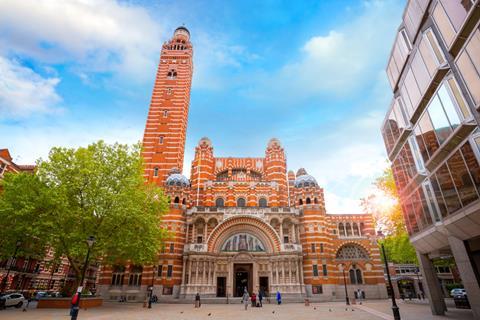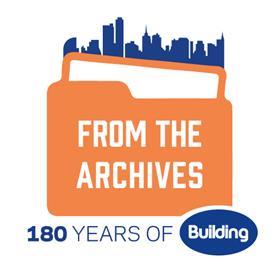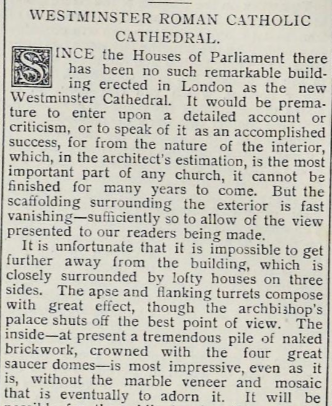The Builder reports on the progress of the UK’s largest Catholic church and the tragic death of its architect

“Since the Houses of Parliament there has been no such remarkable building erected in London as the new Westminster Cathedral,” said The Builder in 1902. The usually hard-to-please magazine was awestruck by the building, the last work by architect John Francis Bentley. It is still the largest Catholic church in the UK, but is also surprisingly obscure. Though grade I-listed, it is relatively unknown even to Londoners, maybe because its name makes it easily confused with the more famous Westminster Abbey.

Today the elaborate Byzantine-style edifice is sandwiched among the glass and steel office blocks of Victoria, and looks completely out of place. Inside it is equally striking, a series of cavernous 100ft-high black brick-faced domes making it unlike almost anything else in the capital. They were originally meant to be covered in golden mosaics, but were never completed.
Bentley was awarded the RIBA Royal Gold Medal in 1902 in recognition of his work. He never received it, as he died on the morning the announcement was due to be made, which meant the award had to be handed to someone else because of a technicality.
Below are a series of news items and the architect’s obituary, charting the design and construction of the building and the dismay over Bentley’s untimely death.
Extract from news item, 6 July 1895
THE NEW ROMAN CATHOLIC CATHEDRAL AT WESTMINSTER
The cathedral, the foundation-stone of which was laid by Cardinal Vaughan on Monday last, will be erected from the designs of My. John F. Bentley. Mr. Bentley is best known by his Gothic buildings, such as the new Catholic Church at Walford, the Preparatory College at Beaumont, and the seminary erected for Cardinal Manning at Hammersmith. The refitting and decoration of the churches of St. Botolph, Aldgate, and St. Botolph, Bishopsgate, however, show Mr. Bentley to be thoroughly at home with the Renaissance style. And we think it will be acknowledged that the difficulties of the Byzantine style have been overcome in the very striking design for Cardinal Vaughan’s cathedral. It is true that the design is in little more than a sketch condition, but the sketches bear promise of a work of singular interest and originality.
The first idea was to build the new cathedral in imitation of “Old St. Peter’s at Rome,” and Mr. Bentley spent several months in Italy at Rome, Ravenna, and other Italian cities, studying the early “Basilica” churches. Although immensely interested with these ancient and beautiful buildings, he came to the conclusion that they were not suggestive of modern treatment, or specially applicable to modern requirements, especially for a London church; much of their beauty depending upon columns and features derived from other buildings, combined together in such a way as to produce that fascinating picturesqueness so attractive to the pencil of the painter, but so unattainable in a modern building, even where much is sacrificed to pure archæology. Then the great wooden roofs of these buildings point to a kind of make-shift construction, which as has been seen in our own time at St. Paul’s, Rome, renders the building an easy prey to fire, and it is certainly absurd at the present day to cover the walls of a building with rich and costly decoration without attempting to render it fire-proof.
On the other hand, the churches of St. Mark, Venice, the cathedral at Murano, St. Vitalis, Ravenna, and St. Ambrogio at Milan seemed to Mr. Bentley to offer admirable suggestions for modern church architecture, especially in a case where it was considered inadvisable to copy the Gothic of the thirteenth, fourteenth, and fifteenth centuries, so Mr. Bentley determined to advise his clients to give up the Basilica idea, and it is greatly to the credit of Cardinal Vaughan that he consented to do this, as it is an example of that kind of understanding and confidence which ought to exist between client and architect, but which, unfortunately, is too frequently absent.
News item, 4 January 1902
WESTMINSTER ROMAN CATHOLIC CATHEDRAL
Since the Houses of Parliament there has been no such remarkable building erected in London as the new Westminster Cathedral. It would be premature to enter upon a detailed account or criticism, or to speak of it as an accomplished success, for from the nature of the interior, which, in the architect’s estimation, is

the most important part of any church, it cannot be finished for many years to come. But the scaffolding surrounding the exterior is fast vanishing - sufficiently so to allow of the view presented to our readers being made.
It is unfortunate that it is impossible to get further away from the building, which is closely surrounded by lofty houses on three sides. The apse and flanking turrets compose with great effect, though the archbishop’s palace shuts off the best point of view. The inside - at present a tremendous pile of naked brickwork, crowned with the four great saucer domes - is most impressive, even as it is, without the marble veneer and mosaic that is eventually to adorn it. It will be possible for the public to view this when it is thrown open for worship shortly after the Coronation, and until the interior is seen no opinion should be expressed upon the merits of the whole.
In our opinion it is a building likely to be regarded by future generations as marking an epoch in English architecture. The plan is eminently suited to a great congregational service; the acoustics are said to be perfect; and the style of architecture is most suitable from economical reasons to a great church. It is at present the one building of absorbing interest to students and to many practising architects besides. Its claim upon our attention is not based upon any mere striking originality, but upon the effective effort of a great mind to solve a problem that is always new and always surrounded by the many cramping conditions of site, requirements, and cost.
News item, 8 Feb 1902
The Royal Institute of British Architects
The Royal Gold Medallist
The Chairman said he had to announce that the Council proposed to submit to his Majesty the King, as a fit person to receive the Royal Gold Medal for 1902, the name of Mr. J. F. Bentley, for his work as an architect.
The announcement was received with much applause.
Obituary, 8 March 1902
THE LATE MR. BENTLEY
It was by a sad coincidence that the news of the unexpected death of Mr. J. F. Bentley was made public on the morning of the day when it was to have been announced at the Institute of Architects meeting that the Gold Medal had been awarded him this year - and indeed it could not well have been otherwise awarded. This is the third tragic fatality in the architectural profession during a very recent period.
By his death we lose a man who to the comparatively few who were acquainted with his work had long been known as a true artist, though it is only his great building at Westminster which has brought him something like public fame. Mr. Bentley was in fact so retiring and reserved a man that it was difficult for any but a few friends to know much about him but he was an example of an architect (there are not too many of them) whose thoughts and endeavours were given rather to the perfecting of his work than to either emoluments or public notice.
It has been related to us that when in his earlier days he had been selected as architect for a proposed church, the committee, after waiting some time, wrote to him to ask when the design would be ready, but received the reply that he had not yet satisfied himself with it. After waiting some time longer a second appeal was made, coupled with an intimation that if he kept them longer they might feel it necessary to go to another architect. Bentley’s reply was that he could not send in a design until he was entirely satisfied that it was the best he could do; but added that if they wished to go to another architect he was quite content that they should do so.
This we may take to be typical of the spirit in which he worked. When a friend congratulated him’ on the fact that the Institute had decided to offer him their Gold Medal, he replied- “Such things are not in my line; I do not appreciate these honours in the least; but (he added very emphatically) I do appreciate the good will of my brother architects in presenting it to me.”
The following extract from a letter sent to us by a younger architect, is interesting as throwing light on Mr. Bentley’s real character, which no doubt was often misunderstood owing to his reserve and a certain brusquerie of manner :-
“My first introduction to him was nearly five years ago on a little matter of private business,, when, in reply to a letter of mine asking for some concession, I received a reply in such curt and uncompromising terms as - much as I wished to: meet him - made me hesitate long before screwing up courage to do so. Upon meeting him, he received me very much in the spirit indicated by his letter. Any attempt at discussion was futile, and we eventually arranged our business on his own terms. Much to my surprise, however, no sooner was this accomplished than he voluntarily made nearly the whole concession I had asked for, and before our interview was at an end (it did not last more than ten or fifteen minutes) I had quite thrown over my previous impressions of his character, for from being resolutely impassive and reserved he seemed to change to a friend of years’ standing, giving me most kindly advice and good wishes as well as encouragement as to the future. This was the side of his character I saw to nearly the day of his death, my last meeting with him being less than a week previous to that sad event. I met him frequently, and never without some kind inquiry on his part, and when it was my good fortune to be able to tell him of some little success, his expression of pleasure and congratulation were most tender, such as one might expect from a father to his son.
During the last year or two he found such difficulty in speaking that I would sometimes attempt to pass him to save him the pain of a conversation, but seldom would he allow this.”
News item, 22 March 1902
The Late Mr. Bentley and the Royal Gold Medal.
The Chairman said he had at the last meeting a painful incident to mention in connexion with the death of Mr. Bentley, who, had he lived, would have been elected the Gold Medallist. As his decease happened before he was elected, the Council felt that they could not proceed to give the gold medal to the members of the family in consideration of his services, without reference to the King - for it was the King’s gift.
Accordingly they wrote to his Majesty, and, in reply, a letter had been received from Sir Dighton Probyn who said that the proposal had received his Majesty’s careful consideration, but that his Majesty, while fully appreciating the kindly feelings which had prompted the Council of the Institute to make the suggestion, was of opinion that unless the Council were in any way pledged to award the medal as proposed, or unless it could be shown that a case similar in character had occurred before, it would create a dangerous precedent if the medal for the current year were given to the family of the late Mr. Bentley on the ground that in virtue of that gentleman’s great services to architecture, the Council would have recommended him for the medal had he lived until the date of their next meeting. Therefore, that settled the question, much as they would have liked to have honoured Mr. Bentley. The Council at their next meeting, would take into consideration the names of other gentlemen and nominate someone else for the gold medal for this year.
More from the archives:
>> Nelson’s Column runs out of money, 1843-44
>> The clearance of London’s worst slum, 1843-46
>> The construction of the Palace of Westminster, 1847
>> Benjamin Disraeli’s proposal to hang architects, 1847
>> The Crystal Palace’s leaking roof, 1851
>> Cleaning up the Great Stink, 1858
>> Setbacks on the world’s first underground railway, 1860
>> The opening of Clifton Suspension Bridge, 1864
>> Replacing Old Smithfield Market, 1864-68
>> Alternative designs for Manchester Town Hall, 1868
>> The construction of the Forth Bridge, 1873-90
>> The demolition of Northumberland House, 1874
>> Dodging falling bricks at the Natural History Museum construction site, 1876
>> An alternative proposal for Tower Bridge, 1878
>> The Tay Bridge disaster, 1879
>> Building in Bombay, 1879 - 1892
>> Cologne Cathedral’s topping out ceremony, 1880
>> Britain’s dim view of the Eiffel Tower, 1886-89
>> First proposals for the Glasgow Subway, 1887
>> Westminster’s unbuilt gothic skyscraper 1904
>> The First World War breaks out, 1914
>> The Great War drags on, 1915 - 1916




























No comments yet